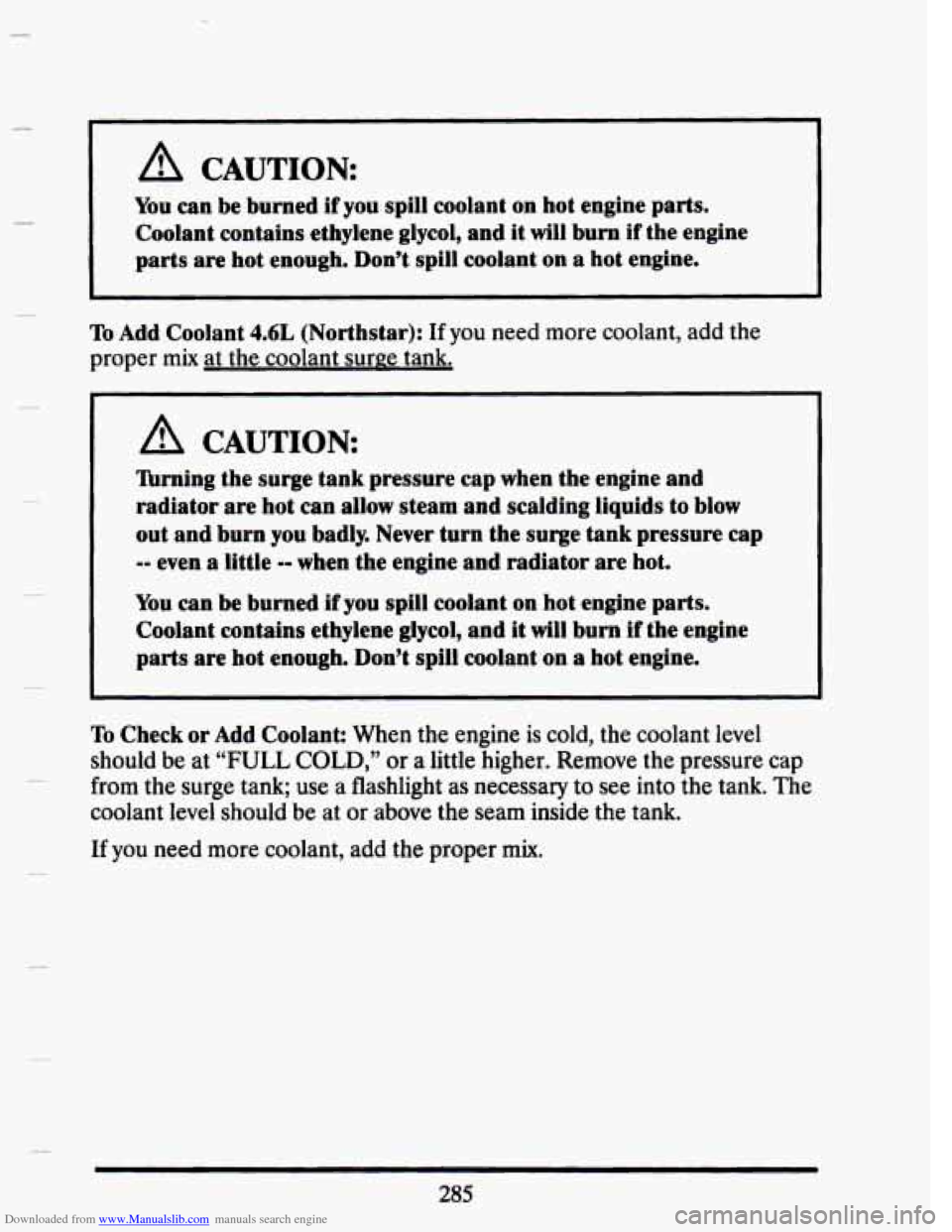Page 249 of 407
Downloaded from www.Manualslib.com manuals search engine COOLING SYSTEM - 4.9 LITER
When you decide it's safe to lift the hood, here's what you'll see:
v Coolant recovery tank
v Radiator pressure cap
Electric engine fans
1 A CAUTION:
An electric fan under the hood can start up even when the
engine is not running and can injure you,
Keep hands, clothing
and
tools away from any underhood electric fan,
If the coolant inside the coolant recovery tank is boiling, don't do
anything else until
it cools down.
235
Page 253 of 407
Downloaded from www.Manualslib.com manuals search engine A CAUTION:
Steam and scalding liquids from a hot cooling system can blow
out and burn you badly. They are under pressure, and if you
turn the radiator pressure cap
-- even a little -- they can come
out at high speed. Never turn the cap when the cooling system,
including the radiator pressure cap, is hot. Wait for the cooling
system and radiator pressure cap to cool
if you ever have to turn
the pressure cap.
239
Page 254 of 407
Downloaded from www.Manualslib.com manuals search engine How to Add Coolant to the Radiator
a , ','> . /. ~ 1. You can remove
the radiator _.II
(Don't press down while turning the pressure cap.)
If
you hear a hiss, wait for that to stop. A hiss means there is still some
pressure left.
2. Then keep turning
the pressure cap,
but
now push
down as you turn
it. Remove the
pressure cap. pressure
cap when
the cooling
system, including
the radiator
pressure cap and
upper radiator
hose, is
no longer
hot.
Turn the
pressure cap
slowly
to the left
until it first stops.
240
I
Page 256 of 407
Downloaded from www.Manualslib.com manuals search engine 5. Put the cap back
on the coolant
recovery tank, but
leave the radiator
pressure cap
off.
you can feel the
upper radiator
hose getting hot.
Watch out for the
engine fans.
7. By this time the coolant level inside the radiator filler neck may be
lower.
If the level is lower, add more of the proper mix through the
filler neck until the level reaches the base
of the filler neck.
242
..
Page 261 of 407
Downloaded from www.Manualslib.com manuals search engine F
P
!
P
c
1. You can remove
the coolant surge
tank pressure cap
when
the cooling
system, including
the coolant surge
tank pressure cap
and upper radiator
hose, is no longer
hot. Turn the
pressure cap slowly
to the
left until it
first stops.
(Don’t press down while turning the pressure cap.)
If you hear a hiss, wait for that to stop. A hiss means there is still some
pressure left.
247
F
Page 298 of 407
Downloaded from www.Manualslib.com manuals search engine When your engine is warm and the “ENGINE COOLANT LOW”
message does not appear on the Driver Information Center, coolant
is at
the proper fill level.
4.9 Liter
To Check Coolant:
When your engine is
cold, the coolant level
should be at
“FULL
COLD,” or a little
higher. When your
engine is warm,
the
level should be up to
“FULL
HOT,” or a
little higher.
To Add Coolant 4.9L If you need more coolant, add the proper mix at
the coolant recoverv tank.
A CAUTION
flrrning the radiator pressure cap when the engine and radiator
are hot can allow steam and scalding liquids to blow
out and
bum you badly. With the coolant recovery
tank, you will almost
never have to add coolant at the radiator. Never turn the
~ radiator pressure cap -- even a little -- when the engine and
radiator are hot.
Add coolant mix at the recovery tank, but be careful not to spill it.
284
Page 299 of 407

Downloaded from www.Manualslib.com manuals search engine I
A CAUTION:
You can be burned if you spill coolant on hot engine parts.
Coolant contains ethylene glycol, and it
will burn if the engine
parts are hot enough. Don’t
spill coolant on a hot engine.
To Add Coolant 4.6L (Northstar): If you need more coolant, add the
proper
mix at the coolant surPe tank.
A CAUTION:
lbrning the surge tank pressure cap when the engine and
radiator are hot
can allow steam and scalding liquids to blow
out and burn you badly. Never turn the surge tank pressure cap
-- even a little -- when the engine and radiator are hot.
You can be burned if you spill coolant on hot engine parts.
Coolant contains ethylene glycol, and it
will burn if the engine
parts are hot enough. Don’t spill coolant
on a hot engine.
To Check or Add Coolant: When the engine is cold, the coolant level
should be at
“FULL COLD,” or a little higher. Remove the pressure cap
from the surge tank;
use a flashlight as necessary to see into the tank. The
coolant Ievel should be at or above the seam inside the tank.
If you need more coolant, add the proper mix.
Page 300 of 407
Downloaded from www.Manualslib.com manuals search engine MUTOR OR SURGE TANK
PRESSURE CAP
When you replace your radiator or surge tank pressure cap, an AC@ cap
is recommended.
THERMOSTAT
Engine coolant temperature is controlled by a thermostat in the engine
coolant system.
The thermostat stops the flow of coolant through the
radiator until the coolant reaches a preset temperature.
When you replace your thermostat, an
AC@ thermostat is recommended.
POWER STEERING FLUID
0
4.9 Liter
286